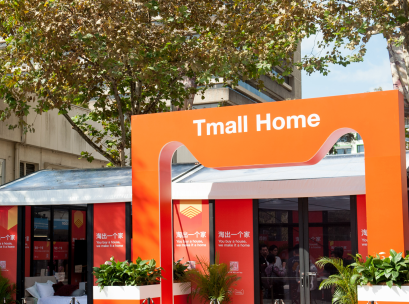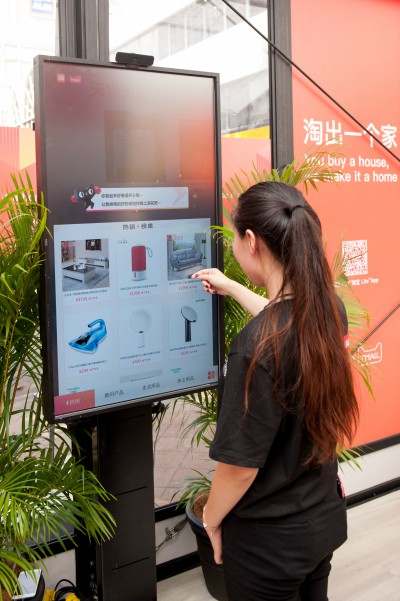 E-commerce powerhouse, Alibaba Group, has given Aussie consumers a glimpse of its ‘New Retail’ strategy via pop-up launches in Australia this week.
E-commerce powerhouse, Alibaba Group, has given Aussie consumers a glimpse of its ‘New Retail’ strategy via pop-up launches in Australia this week.
Set in an apartment style store space at Westfield Chatswood in Sydney’s north, Alibaba’s first Aussie pop-up featured technologies that the e-commerce giant thinks are the future of online and offline shopping.
With the location only operating for less than a week – ahead of another temporary location launching later this week at QV Melbourne – Alibaba is using the stores to demonstrate where it thinks the retail industry is headed.
“We’re driving this new retail strategy in China where we believe payments, entertainment, online and offline are going to merge into one seamless experience for the consumer,” said James Hudson, Alibaba Group director of corporate affairs and marketing, on a walk-through tour of the pop-up. “It is extraordinary how fast this is happening in China.”
Alibaba is also using the pop-ups to show various CTOs and technology teams from local retailers the ways in which it is pushing away the “either-or” retail equation, in favour of a model that melds both in-shop and online experiences.
The store features augmented reality, AI mirrors and virtual, cloud-enabled shelf technologies. All products in the pop-up have QR codes that are scanned using the app from Alibaba’s subsidiary shopping website,Taobao, which is immediately linked to its online merchandise.
Hudson said the ‘cloud shelf’ enables retailers to showcase a whole range of products that they wouldn’t be able to stock in their store otherwise. Geotag technology on products also allows consumers to scan and find out more information or buy products.
Using video recognition, consumers can also have product recommendations supplied by staring into digital screens that find products based on a customer’s mood.
Raymond Ma, head of ASEAN and ANZ for Alibaba Cloud said while the cloud supports all infrastructure requirements, the most important aspect is the big data analysis that AI offers.
Entertainment, according to Hudson, is also a major component of New Retail.
“We want to drive consumers to want to visit offline stores because it gives them more choice and allows retailers to do a whole range of different merchandising solutions.”
 With the majority of Alibaba shoppers falling under the age of 30, the pop-up incorporates a gaming element – with consumers able to play online games to accrue points for shopping discounts or win coupons.
With the majority of Alibaba shoppers falling under the age of 30, the pop-up incorporates a gaming element – with consumers able to play online games to accrue points for shopping discounts or win coupons.
Only Chinese migrants or those with a Chinese bank account are able to shop at the locations.
More partnerships, not store fronts in Oz
Hudson said there are no plans for Alibaba to roll-out store fronts in Australia, with the company instead focusing on building partnerships with local retailers.
Alipay is also on the rise locally, with 8,000 retailers now accepting Alipay – the company’s payments platform – from Chinese consumers.
While online sales penetration in China the highest in the world, brick-and-mortar retail still accounts for more than 80 percent of total retail sales.
Alibaba’s Hema supermarkets have also continued to roll-out in China, with 38 opened in 18 months and 100 more to open over the next year.
The supermarkets sell groceries, fruits, vegetables and fresh seafood. Consumers are able to take fresh products, including seafood, raw or cooked, or have it prepared to eat in-store.
For consumers who live within three kilometres of the market, Hema supermarkets deliver goods within 30 minutes. Each store serves as its own warehouse and logistics centre that collects, fulfils and delivers customer orders as fast as they come in, online or offline.
Other initiatives that Alibaba is rolling out include auto vending machines, with the first launched in partnership with Ford in the southern city of Guangzhou.
The Ford auto vending machine lets customers browse makes and models inside their app, choose one they want to test drive, pick it up from an unmanned vending machine and drive it for up to three days, before making an appointment to visit a dealer when they’re ready to buy.
This article first appeared in this week’s edition of Inside Retail Weekly.
Access exclusive analysis, locked news and reports with Inside Retail Weekly. Subscribe today and get our premium print publication delivered to your door every week.





